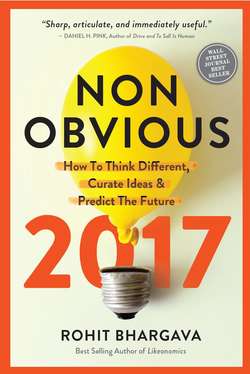Читать книгу Non-Obvious 2017 Edition - Рохит Бхаргава - Страница 52
На сайте Литреса книга снята с продажи.
Step 3—Elevating
ОглавлениеPhoto: Example of how elevating ideas lead to possible trend descriptions.
Elevating means thinking bigger about the underlying themes that connect groups of ideas to describe a single broader concept.
If you have gone through gathering and aggregating ideas—this is the point where you will probably confront the same problem I do every year.
There are too many possibilities.
When I go through my annual exercise of curating trends, the first time I aggregate all of my ideas it usually yields between 70 and 100 possible trend topics. That is a sign that there is more work to be done.
So, in this third step, the aim is to take a bigger view and connect groups of ideas together into something that could eventually describe a trend.
| ELEVATING QUESTIONS—How to Think Bigger about Ideas |
| What interests me most about these ideas?What elements could I have missed earlier?What is below the surface?What is the bigger picture?Where is the connection between ideas? |
This can be the most challenging phase of the Haystack Method as combining ideas can also lead you to unintentionally make them too broad (and obvious). Your aim in this step therefore must be elevating an idea to make it bigger and more encompassing of multiple examples.
For example, when I was producing my 2014 Non-Obvious Trend Report I came across an interesting healthcare startup called GoodRx, which had a tool to help people find the best price for medications. It was simple, useful and the perfect example of an evolving shift toward empowering patients in healthcare, which I wrote about in my earlier book ePatient 2015.
At the same time, I was seeing retail stores like Macy’s investing heavily in creating apps to improve their in-store shopping experience, and a suite of new fashion services like Rent the Runway designed to help people save time and money while shopping.
On the surface, a tool to save on prescriptions, an app for a department store and a crowdsourced tool for renting dresses don’t seem to have much in common. I had therefore initially grouped them separately.
While elevating trends, though, I realized that all of them had the underlying intent of helping to optimize a shopping experience in some way. I put them together and ultimately called the trend Shoptimization, to describe how technology was helping consumers optimize the process of buying everything from fashion to medical prescriptions.
In the next step, we will talk about techniques for naming trends (and the backstory behind the term Virtual Empathy), but for now my point in sharing that example is that elevation is the step in the Haystack Method where you can start to make the connections across industries and ideas that may have initially seemed disconnected and fallen into different groups.
I realize the difference between aggregating ideas and elevating them may seem very slight. In fact, there are times when I manage to do both at the same time because the act of aggregating stories together may help you to broaden your conclusions about them.
In the Haystack Method, I chose to still present these steps separately because most of the time they do end up as distinct efforts. With practice though, you may get better at condensing these two steps together.
